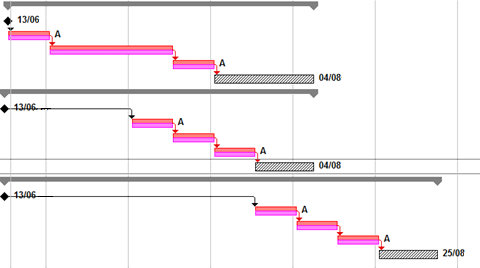Critical Chain
in a project portfolio
- Home >
- The Method >
- Critical Chain applied to a project portfolio
How to implement Critical Chain in multi-project environments

It is increasingly rare for a company to only have one on-going project to manage. On the contrary, nowadays, companies are managing a multitude of projects in parallel which often call upon the same resources.
In such an environments, conflicts between projects are common. The same is true for changes in priorities: decisions have become a headache, between the late and strategic project and the very late project!
Most often decisions are made on the basis of a feeling or under the pressure of a client or the hierarchy. However, these decisions can have a negative impact on the rest of the portfolio.
The Critical Chain method, described previously for a single project, is also applicable to a portfolio of projects and uses the same principles and tools, including the flagship indicator: the Fever Chart.

Planning the Critical Chain way each project in a portfolio is not sufficient to be able to manage it effectively; other elements of the Theory of Constraints should be added.
A postulate of the Theory Of Constraints is that there is always a bottleneck surrounded by non-bottleneck resources. To increase the performance of the whole, it suffices to focus on this resource.

What is a project portfolio?
To better understand how the Critical Chain works in a multi-project environment, it is important to first know what a portfolio of projects is.
It is customary to consider a portfolio in relation to a typology of projects or by the set of projects managed by one person.
However, a project portfolio is a set of projects for a given resource perimeter: there cannot be any resource conflict between two project portfolios.

Therefore, with Critical Chain Project Management, two types of constraints must be considered in multi-project environments:
- The constraint of a project: its Critical Chain, which determines the project duration,
- The constraint of a project portfolio: a resource, which limits the system’s ability to generate more turnover.

As in the case of the Theory of Constraints in production, in a multi-project environment, it is necessary to protect the constraint and manage the system according to this resource's capacity. In other words, the projects are launched according to the availability of the capacity constraint.
Moving forward the starting dates of projects according to the bottleneck in the portfolio is called "staggering".
Thanks to staggering, the work-in-process is limited, and therefore so is multitasking which is one of the greatest - if the greatest - source of inefficiency and degradation of quality. In particular, helping the critical resources reduce their multitasking is key for multi-project performance.
Staggering of a 3-project portfolio, the capacity constraint of which is the resource A:

Stop starting, Start finishing
Staggering helps to protect the capacity constraint against conflicts between projects; however, this does not solve all the resource conflicts between projects.
In the event of a conflict over non-bottlenecked resources, dynamic arbitration is necessary:
- It is essential that the projects' priority order is established, clear and shared.
- The decision must be made using factual data and allowing a fair comparison of all projects: the Portfolio Fever Chart.
The Portfolio Fever Chart makes easier the management of the entire project portfolio, objectively and transparently.
The Portfolio Fever Chart principle is identical to the Project Fever Chart: the green zone is the safety zone, the yellow zone is the warning zone, and the red zone is the danger zone where projects are likely to finish late.

If there is a resource conflict between several projects, the Fever Chart allows you to identify the most critical project in a very simple way. For example, we will favor the allocation of a resource to project P1 rather than to project P10.
Conclusion

Managing a project portfolio when all projects are planned the Critical Chain way is greatly facilitated by a regular analysis of the portfolio Fever Chart. Indeed, the "portfolio management" fosters focus on the few projects in the red and yellow zones; there is no need to spend too much time scrutinizing projects in the green zone.
Of course, the ability of the business to increase the number of projects completed over a period of time will depend on the capacity constraint of the project portfolio. Is this constraint in the right place? Is it possible to increase its capacity and therefore increase the company's capacity to carry out projects? Theory of Constraints and Lean seeks to answer these questions.
The steps to monitor a project portfolio thanks to the Critical Chain method echo the process of continuous improvement of the Theory of Constraints, the "5 focusing steps". Staggering, which is the "subordination" step, is therefore not the finishing line of the method implementation.
